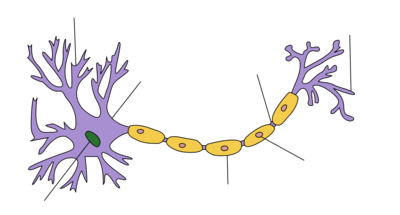Structure of a typical neuron
| Soma
|

Dendrite
Soma
Axon
Nucleus
Node of
Ranvier
Axon terminal
Schwann cell
Myelin sheath |
The
soma or
soma is one of the three primary parts of the neuron. It is the metabolic center of the neuron and contains the nucleus, which stores all the genetic material for the organism, and the endoplasmic reticulum which synthesizes all of the cellular proteins. The soma develops two projections, one called the dendrites receives input from other cells, while the other the axon outputs information from the soma. The individual dendrites, when activated, either send an inhibitory or excitatory impulse to the soma. The soma then integrates all the activated dendrites and if certain threshold values are reached it alters its firing response along the axon. When a neuron decides to fire it activates an action potential which creates an electrical impulse that travels down the axon. When the impulse reaches the end of the axon it releases neurotransmitters into the space between where the axon ends and another cell's dendrites begin. This space is called the synaptic cleft. The released neurotransmitters may activate dendrites for other cells. Through this mechanism of communication and impulse propagation the nervous system is able to sense the environment, integrate information and alter behavior.
References[edit]
Martin, JH (2003). Neuroanatomy text and atlas 3rd ed., New York: McGraw-Hill.
 From Conservapedia
From Conservapedia 
 ZWI signed:
ZWI signed: KSF
KSF